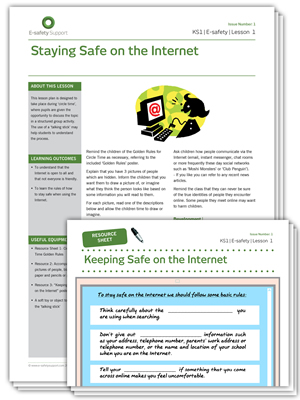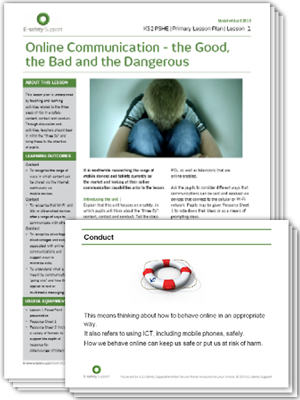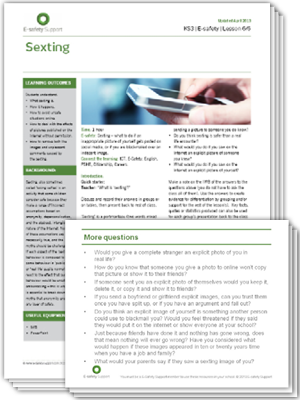Safeguarding Essentials Resources - Lesson Plans
Lesson Plans
Safeguarding Essentials has 27 lesson plans - scroll down for details and samples
Written by teaching professionals with expertise in safeguarding and e-safety, these lesson plans help to enrich your curriculum, and can be delivered through PSHE, citizenship or ICT lessons. They include PDF lesson plan overviews and PowerPoint slides, and can be delivered by non-specialist teachers. The lesson plans are designed to encourage pupils to create their own resources for safeguarding and e-safety, to input into the school policy and to promote peer mentoring.
Displaying all Lesson Plans

This key stage 1, primary circle time resource allows teachers to focus on developing children’s awareness and knowledge of staying safe whilst using the Internet. The resource engages with the primary PSHE curriculum and teaches young children that there are adults, using the Internet, who pretend to be children to form inappropriate relationships with them.
Through engaging exercises, the circle time activity offers advice and explanation about staying safe whilst using the Internet without frightening primary-age children. The activity concludes with the children developing their own set of rules and turning them into a poster. This activity reinforces what they have learnt and allows them to recall the rules of safe Internet use when they are using the Internet at home.

This key stage 2 lesson plan is underpinned by teaching and learning activities related to the three areas of risk in e-safety: content, contact and conduct. Through discussion and activities, teachers explore the range of ways in which content can be shared via the Internet, specifically mobile devices. The lesson helps children understand how Wi-Fi and 3G- or 4G-enabled devices offer a range of ways to communicate with others and receive communications, and identifies the advantages, disadvantages and dangers associated with online communications while suggesting ways in which risks can be minimised.
The lesson also covers what is meant by communications ‘going viral’ and how this applies to text or multimedia messaging.

Research shows that many children play console or online games and watch films that are classified as being suitable for older users. This lesson is designed to help children make more informed decisions about the games they play or the movies they watch. What are classifications and how do they work? What is the difference between movie and gaming classification systems? The lesson also tackles the issue of how to assess the risk of watching unrated video online, and how children can deal with something they have seen that upset them.
The key stage 2 lesson includes links to relevant multimedia online, so will work best if you are able to use a whiteboard or projector.

The ability to evaluate websites for their validity is highly important as children increasingly turn to online content for research purposes. In this lesson children understand that online content can be unreliable, and it can be used to pass on fiction and myths. The children use an example of a spoof website to help them identify suspicious information. Unreliable online information can compromise their ability to learn and understand the world, so it is important that they learn how to spot it, and check data. The lesson also explores how to spot scams or fraud, and what to look out for.
Included in this KS2 resource are a PowerPoint presentation and a website evaluation form template to be used by the children when examining online sources of information.

Anyone who has seen children merrily copying and pasting images from the Internet into their homework or searching Wikipedia for information on a topic, knows that knowledge and understanding of the concept of copyright needs to be absorbed very early on, to prevent plagiarism incidents at secondary school or university. As well as understanding that information online is not always correct, children also need to know that websites and the content of websites are protected by copyright, in just the same way as books are. Young people need to understand that taking information from the Internet can have legal implications and puts individuals at risk of breaking the law.
This KS2 lesson could form the basis for the next lesson, where children share their learning about e-safety and issues related to use of online content with a wider audience. It includes links to useful websites that can help with this potentially complex issue, a PowerPoint presentation and resource sheet.

This lesson gives key stage 2 pupils an opportunity to collate all their online safety learning from previous lessons, all their e-safety knowledge, and create a display, presentation or factsheet summarising their knowledge for the rest of the school and potentially their parents too.
You could use the key messages from this session to create an e-safety charter, which feeds into the schools e-safety policy, which is “good or outstanding” practice according to Ofsted.

In this assembly designed for key stage 1 and 2, children will learn to judge what kind of physical contact is acceptable and comfortable or unacceptable and uncomfortable. They will also learn how to respond (including who to tell and how to tell them).
-
 Teacher Guide for Abuse Lesson
Teacher Guide for Abuse Lesson
-
 Class Presentation for Abuse Lesson
Class Presentation for Abuse Lesson

The aim of this lesson is to help students decide what safeguarding includes and what we are safeguarding against.
The lesson is based around a series of scenarios through which the students will consider if a safeguarding issue is taking place.
-
 Teacher Guide for Safeguarding Lesson
Teacher Guide for Safeguarding Lesson
-
 Class Presentation for Safeguarding Lesson
Class Presentation for Safeguarding Lesson

Cyber bullying is an issue that most young people will be familiar with. In this lesson, students consider the long term implications of cyber bullying. Using scenarios provided, they work in small groups to assess the risks associated with cyber bullying for everyone concerned. They summarise the risks, consequences and likelihood of these consequences for the parties involved and develop posters or display materials for use in the school.

This lesson is all about using Facebook, Twitter and social media networking sites. At the end of the lesson the students will be able to create a poster or display offering social media e-safety advice to other students.
The students are asked to consider the legal implications of the things that are written online by themselves or about themselves online, on social networking sites. Using scenarios, the students have to match the scenarios with the relevant law, and consider the outcomes from a legal perspective.

In this lesson, students are asked to consider how comments made online on social networking sites such as Facebook and Twitter may be perceived by others. It is designed to encourage them to “think before they post” online, and understand how easy it is to write something online that you may end up regretting. During the lesson they consider some quotes that people could post online, and explore how a comment can escalate into full blown cyber bullying.
This is followed by a group exercise with role play to understand how negative comments online develop into conversations. The students then consider how the victim of the bullying would feel, how their family would feel when they saw the comments, and what a stranger might think if they saw the conversation.

Cases have been documented where teachers, young people, parents and even schools have been the victims of impersonation online. In this lesson, students consider what to do if you are being impersonated on Facebook, what to do if you see a Facebook account which you think is impersonating someone you know and how to deal with the effects of being impersonated and seeing someone write unpleasant comments pretending to be you. Students are given a scenario, which they then use as the basis of an investigation into online impersonation, and how you can deal with an imposter account on Facebook. They then create a guide for dealing with impersonation which can be used by other students.

In this lesson, students learn about the risks of “Frape” where someone else uses your Facebook account to send malicious messages, indecent photos or to generally disrupt your online presence. The activity, while focused on Facebook, is helpful in that it is essential that young people understand how and why website security systems work, and how they can make their online behaviour more secure, and take effective steps to keep passwords and logins safe.
The lesson includes a number of relevant links, so having Internet access during the session is recommended.

Sexting, also sometimes called ‘taking selfies’ is an activity which some children consider safe due to a range of incorrect assumptions based on anonymity, depersonalisation, and the abstract, intangible nature of the Internet. None of these assumptions are necessarily true, and the myths should be challenged. If each aspect of the ‘sexting’ behaviour is compared to the same behaviour in ‘public’ or ‘real life’ pupils normally react to the effect that such behaviour would be unsafe or embarrassing in ‘real life’ – this is why it is essential to break down the myths that anonymity provides any layer of safety.
In this lesson, groups of students produce a poster or guide to display advice on what sexting is, how it happens, and how to avoid unsafe situations online, how to deal with the effects of pictures published on the Internet without permission, and how to remove both the images and unpleasant comments caused by the sexting.
The lesson includes practical advice for dealing with sexting, including reporting procedures and the law.

Many young people are unclear about the law relating to file sharing, even in years 9 and 10. This lesson explains exactly what “peer to peer” or “p2p” file sharing is, and which sites are legal. Students learn why p2p networks can be dangerous facilitators of malware and viruses, why p2p networks can facilitate copyright infringement, and how illegal downloads can be traced. An important element of this learning is the understanding of what the potential consequences of illegal downloading can be.
The lesson plan involves a mock trial, where students role play the opposing sides in a case where a student is being prosecuted for illegal file sharing. It also includes useful links for reference, and background information for the teacher.

A digital footprint, also known as a digital shadow, is the trace of a person’s online activity visible on search engines such as Google, social media platforms such as Facebook and Twitter, and image searches such as Google images and Flickr. We all have digital footprints these days, the important thing is to manage them, remembering that the things that we post online, are often difficult to remove.
This lesson reminds students that future employers and universities may search the social media profiles of applicants. The students access the Internet to search online for anything relating to them, to see what their digital footprint is currently like. The pupils develop advice on which websites users need to be wary of and carefully consider what information they upload. They can then develop a series of guidelines aimed at Y7-8 designed to minimise the possibility of negative search results in future.

Certain websites are more likely to foster negative online behaviour than others, and those that encourage Q&A or ratings are often sources of concern for young people who have been targeted with abuse or inappropriate approaches from people they know who are posting anonymously, from people they know who are quite open about their identity or from complete strangers. This lesson shows users how to avoid cyber bullying situations on ratings and response sites, what to be aware of when posting personal comments and the dangers of material being copied across sites and devices.
Using scenarios and role play, students develop strategies for dealing with this kind of cyber bullying and for reporting incidents. The lesson includes opportunities for the students to develop materials for their peers, younger students and the wider school community.

Copyright infringement is common in schools amongst pupils – normally because of ignorance regarding copyright law and the relative ease to find and copy images without considering copyright licenses. Creative Commons is a system of licensing which allows use, reuse, remixing with permission, and legally – provided the user attributes the author in the manner defined in the license. Pupils need to know where to find appropriate content, and how to select material based on a suitable license for their intended use. They also need to be aware of the potential consequences of copyright infringement.
This lesson enables the students to discover how they can use images, information and other media in their own work without breaching copyright rules.

In this lesson students learn how to avoid fraud, phishing, viruses and malware by email. They also learn how to effectively report spam. This is a useful lesson for those students less familiar with email, who may be using it on work placement or in the workplace.
The lesson gives the class an understanding of what spam is and how it works, as well as how to avoid it. Using a number of example emails, the students examine them to see which they think are spam, and why. They then create a display or presentation on the topic for other students, giving their top tips.

Video hijacking, also sometimes called ‘videojacking’ describes a situation where a video has been taken of someone in an embarrassing situation, a situation likely to provoke negative responses, or where a video has been copied, stolen and edited to portray the subject victim in a negative or derogatory light. In this lesson students understand the implications of video hijacking, and the risks of posting video on YouTube. They use real life scenarios to explore the ramifications of the issue, then develop approaches to dealing with it.
The lesson plan also gives them practical strategies for removing video content from YouTube, and asks them to create resources that share their learning with others.

In this lesson students explore different sources of information about sex and relationships and understand the advantages and disadvantages of each. They will be able to define pornography and understand what is, and is not, legal. The lesson helps students understand why people use pornography, issues of consent and respect and dealing with the prevalence of online pornographic content. The lesson includes a quiz, discussion sheet, scenarios and a lengthy PowerPoint presentation to guide teachers through these sensitive issues.

Following on from the previous lesson, this plan continues young people's exploration of the ways in which sources of information about sex can affect values, attitudes and beliefs. The students consider ad campaigns and how they are sold products through sexual imagery and connotation. They are encouraged to focus on how the prevalence of this kind of imagery shapes our beliefs, values and attitudes. The lesson includes two worksheets, useful links and a PowerPoint presentation.

"Sexting" is an increasingly common problem for young people, with pressure to look and behave certain ways from their peers and the media, and a celebrity culture that promotes attention-seeking behaviour. In this lesson, students consider different scenarios involving sexting, and understand the social and legal implications. The lesson includes worksheets, quiz, information sheet and PowerPoint.

Many young people may exhibit inappropriate sexual behaviour, or experience it at the hands of their peers. This lesson plan explores how and why this may happen, and helps young people to deal with it. It considers such behaviour as part of a spectrum, ranging from sexual jokes and bullying through to harassment and sexual exploitation. Students explore the wider social contexts and influences in society and culture. The lesson includes worksheets, role plays for students and a comprehensive PowerPoint presentation.

In this lesson on anti-radicalisation and extremism, students will think about their likes and dislikes in life and who influences their choices.
Students will learn to look at how individuals and groups radicalise others using the Internet. They will understand what is meant by online radicalisation and why people are targeted. They will also learn to be aware of the ‘push’ and ‘pull’ factors related to victims of extremists and know how to support someone who is being targeted by extremists.
-
 Teacher Guide for Online Extremism
Teacher Guide for Online Extremism
-
 Class Presentation for Online Extremism
Class Presentation for Online Extremism
- Safeguarding & E-Safety:
- Online Checklist
- Guidance Documents
- Support and Advice
- News & Information Widget
Get started with free safeguarding and e-safety guidance and articles in our regular email updates and special reports.
Join as a E-safety Support member for access to Internet safety specific online training modules for staff, governors, pupils and parents, school e-safety policies, lesson plans and teaching resources.
Join our full Safeguarding Essentials service for all the fantastic e-safety resources, plus more online training, classroom resources, policies and parent guides covering the wider safeguarding topics.
Discounts available for school groups, small schools and special needs schools - please call 0113 526 5980
* All prices are shown excluding VAT. This is a subscription product with an automatic annual renewal.
Renewal can be cancelled at any time up until midnight on the last day of the current subscription.

